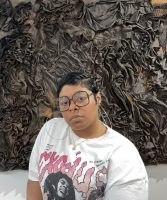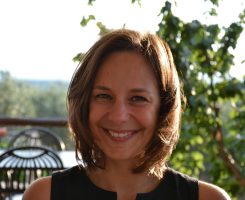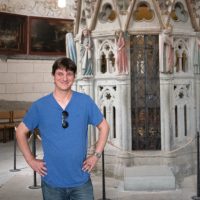CAA News Today
Millard Meiss Publication Fund: Apply Now + Congrats to Spring 2024 Grantees!
posted by CAA — June 07, 2024
CAA is now accepting applications for the Millard Meiss Publication Fund. Twice yearly, grants are awarded through this fund to support book-length scholarly manuscripts in art history, visual studies, and related subjects which have been accepted by a publisher on their merits but cannot be published to their greatest potential without a subsidy. Thanks to the generous bequest of the late Professor Millard Meiss, CAA has been awarding these grants since 1975.
Learn more about the application process and apply here.
Deadline: September 15
Congratulations to the Meiss Spring 2024 Grantees!
Shira Brisman: The Goldsmith’s Debt: Conceptions of Property in Early Modern Art, University of Chicago Press
Atreyee Gupta: Non-Aligned: Art, Decolonization, and the Third World Project in India, Yale University Press
Peyvand Firouzeh: Intimacies of Global Sufism: The Making of Ne‘matullahi Material Culture between Early Modern Iran and India, Indiana University Press
Sherry Fowler: Buddhist Bells and Dragons, Under and Over Water, In and Out of Japan, University of Hawaii Press
Brendan McMahon: Iridescence and the Image: Material Thinking in the Early Modern Spanish World, Penn State University Press
Winnie Wong: The Many Names of Anonymity: Portraitists of the Canton Trade, University of Chicago Press
2024 Art History Travel Fund Grantees Announced!
posted by CAA — April 29, 2024
The Art History Fund for Travel to Special Exhibitions is designed to grant instructors of qualifying art history classes the resources to attend special museum exhibitions both in the US and abroad. These grants cover travel, accommodation, and admission fees for selected classes up to $10,000. Congratulations to the 2024 grantees!
University of Mississippi
Instructor: Kris K. Belden-Adams
Course: Art Now (Art of the 21st Century)
Exhibition: Whitney Biennial 2024
Location: The Whitney Museum, New York City
Penn State University
Instructor: Lindsay S. Cook
Course: Theories and Practices of Conservation
Exhibition: Rediscovering the Sculptures from Notre-Dame and The Medieval Library of Notre Dame of Paris
Location: Musée de Cluny, Paris
Applications for the next round of grants will be accepted by CAA beginning in fall 2024. Questions about the program can be sent to Cali Buckley, Manager of Grants and Awards and Director of the CAA-Getty International Program.
Call for Nominations: Jury Members for CAA Grants and Awards (2024–2027)
posted by CAA — April 03, 2024
CAA invites nominations and self-nominations for individuals with relevant expertise to serve on our juries for Awards for Distinction, Publication Grants, Travel Grants, and Fellowships. Jury service is one of the most impactful volunteer positions at CAA; help select our next awardees and grantees!
To apply, send an e-mail to Cali Buckley, CAA Manager of Grants and Awards & Director of CAA-Getty International Program, with the following:
- Statement of interest outlining qualifications and experience of nominee (150 words maximum)
- CV (two pages maximum)
Three-year terms begin in July. Current CAA Committee and Editorial Board members are not eligible to apply.
Deadline: June 1, 2024
CURRENT JURY OPENINGS
- Art Journal Award
- Charles Rufus Morey Book Award for Non-catalogue Books in the History of Art
- Arthur Kingsley Porter Prize for Art Bulletin articles
- The CAA/American Institute for Conservation Award for Distinction in Scholarship and Conservation
- Jury for the Artist Award for Distinguished Body of Work, Distinguished Artist Award for Lifetime Achievement, and Distinguished Teaching of Art Award
- Distinguished Feminist Awards for Scholars and Artists
- Millard Meiss Publication Fund for Books in Art History
- Wyeth Foundation for American Art Publication Grant
- Art History Fund for Travel to Special Exhibitions
- Professional Development Fellowship in Visual Art
- Michael Aurbach Fellowship for Excellence in Visual Art
Michael Aurbach Fellow Announced!
posted by CAA — March 04, 2024
Congratulations to this year’s recipient of the Michael Aurbach Fellowship for Excellence in Visual Art, Sara Torgison!
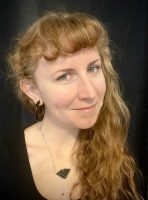
Sara Torgison is an interdisciplinary artist working in ceramic, fiber, and found materials. Her work builds into and extends finite and fragile surfaces to emphasize and inhabit marginal spaces. Strange alliances formed in passages between hard and soft substances are resonant of the shifts inherent in navigating public and private life and the distance between self and other. The action of configuring bridges in transitional zones draws upon traditions of mending and maintenance as a continuous collaborative process.
Sara received an MFA from the University of Cincinnati Department of Design, Architecture, Art and Planning, and a BFA from the California Polytechnic University, Humboldt. Sara is currently Visiting Ceramics Faculty at Miami University of Ohio, and works as a preparator at the Contemporary Arts Center in Cincinnati. She has participated in various artist residencies and workshops, including Penland School of Craft’s winter residency for which she was awarded a distinguished fellowship in 2024. Sara was a 2023 Ohio Arts Council Creative Excellence Grant recipient. Her work is widely exhibited and collected throughout the United States.
HONORABLE MENTIONS

Alex Lukas was born in Boston, MA. With a wide range of influences, Lukas’s practice is focused on the intersections of place and human activity, narrative, history, and invention. His fieldwork, research, and production reframes the monumental and the incidental through intricate publication series, sculptures, drawings, prints, videos, and audio collages. Lukas’s work has been exhibited nationally and internationally, and is included in the collections of the Pennsylvania Academy of the Fine Arts, the Kadist Foundation, the Philadelphia Museum of Art, the San Francisco Museum of Art library, the New York Public Library, and the library of the Museum of Modern Art, New York. Lukas has been awarded residencies at the Bemis Center for the Arts, the Ucross Foundation, the Center for Land Use Interpretation, the Fountainhead, and the John Michael Kohler Arts Center’s Arts/Industry program, among others. He graduated with a BFA from the Rhode Island School of Design in 2003, and received an MFA from Carnegie Mellon University in 2018. Lukas is currently an Assistant Professor of Print and Publication in the Department of Art at the University of California, Santa Barbara, and organizer of CA53776V2.gallery, an experimental exhibition platform on the dashboard of a 2007 Ford Ranger.
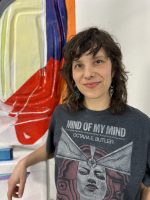
Kristy Hughes is a sculptor, painter, and educator. She received her MFA from Indiana University and her MA and BA from Eastern Illinois University. Hughes was awarded a 2022–23 Visual Arts Fellowship at the Fine Arts Work Center in Provincetown, MA, and has held residencies at the ChaNorth Artist Residency, Hambidge Center for Creative Arts and Sciences, Liquitex Residency at Residency Unlimited, the Studios at MASS MoCA, and a full fellowship at the Vermont Studio Center. Recent solo and group exhibitions include: the Sculpture Center in Cleveland, OH; Provincetown Art Association and Museum, Provincetown, MA; ChaShaMa, New York; Hudson D. Walker Gallery, Provincetown, MA; Soft Times Gallery, San Francisco, CA; Wassaic Project, Wassaic, NY, in addition to exhibitions at universities in North Carolina and South Carolina. Her work has been featured most recently in Maake magazine, New American Paintings, Friend of the Artist, Create magazine, and Vast magazine. Hughes is a full-time lecturer at the University of Vermont in Burlington, VT, where she teaches sculpture, painting, and drawing.
CAA 2023 Professional Development Fellows Announced
posted by CAA — February 05, 2024
Congratulations to our 2023 Professional Development fellows, Zoe Weldon-Yochim, University of California, Santa Cruz (Art History) and Kelly Tapia-Chuning, Cranbrook Academy of Art (Visual Art)!
Honorable Mentions: Jocelyn E. Marshall, Emerson College (Art History); Breanna Reiss, University of New Mexico (Art History); Jessica Monette, Stanford University (Visual Art).
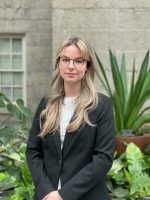
Zoe Weldon-Yochim is a PhD Candidate in Visual Studies at the University of California, Santa Cruz, whose areas of specialization include the art and visual culture of the United States, global contemporary art, and the theories and methods associated with ecocriticism. Her research involves attending to how various artists grapple with the difficulties of visuality and environmental injustices, particularly the long-term and often invisible slow violence of US militarism, nuclear toxicities, and extraction. Her dissertation, “Atomic Afterlives: Visualizing Nuclear Toxicity in Art of the United States, 1979–2011,” focuses on a selection of underrepresented American artists whose work, stemming from genealogies of research-based conceptual art and documentary practices, brings nuclear histories and concerns into aesthetic form in singular, conflictual, and shared ways. In this project, Weldon-Yochim examines how diverse visual approaches—such as installation, photography, print media, and painting—mediate, represent, and give agency to the nuclear and its atomic afterlives. Her research illuminates burgeoning artistic conceptualizations of the intersection of militarism and environmentalism during and beyond the last decade of the Cold War, where particular women, Indigenous, and Asian American artists mobilized varying visual grammar to consider the interconnectedness of environmental injustices and an ever-expanding US military system. Weldon-Yochim’s work has been supported by the American Council of Learned Societies and the Henry Luce Foundation, the Smithsonian American Art Museum, the Center for Advanced Study in the Visual Arts, and numerous university grants.
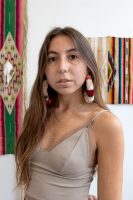
Kelly Tapia-Chuning is a mixed-race Chicana artist of Indigenous descent from southern Utah who is currently based in Detroit. Tapia-Chuning’s work forms as a response to her family’s histories of assimilation, questioning power dynamics attached to representation, racial identity, and language. Tapia-Chuning utilizes research, textile deconstruction, and needle-felting to convey the dichotomy of being nepantla, born in-between spaces and cultures.
In 2020, she received a BFA in Studio Arts from Southern Utah University and is pursuing an MFA in Fiber at Cranbrook Academy of Art, where she was awarded a Gilbert Fellowship. Tapia-Chuning’s work has been included in exhibitions at the Utah Museum of Contemporary Art, GAVLAK (Los Angeles), Onna House (East Hampton, NY), The Border Project Space (NY), and solo exhibitions with Red Arrow Gallery (Nashville, TN) and Harsh Collective (NY). She has been an artist in residence at Stove Works (Chattanooga, TN), and Zion National Park, in Utah. Tapia-Chuning’s work is in numerous public and private collections across the US.

Jocelyn E. Marshall is faculty in the Departments of Visual & Media Arts and Writing, Literature, & Publishing at Emerson College. She previously was a Dissertation Scholar at Brandeis University’s Women’s Studies Research Center. Their interdisciplinary projects focus on contemporary US-based diasporic women and LGBTQ+ artists and writers, researching relationships between historical trauma and queer and feminist activism. Her work has appeared or is forthcoming in the Journal of American Culture, Women & Performance: A Journal of Feminist Theory, Public Art Dialogue, and elsewhere. In 2022, they co-edited Trauma-Informed Pedagogy: Addressing Gender-Based Violence in the Classroom, and in 2023 edited a multimedia issue of Rutgers University’s Rejoinder journal, themed Textual-Sexual-Spiritual: Artistic Practice and Other Rituals as Queer Becoming and Beyond. She also curates contemporary art exhibitions, including Being In-Between | In-Between Being (2020–21) and Creativity in the Time of Covid-19 (2023). She currently co-chairs the Gender & Feminisms Caucus at the Society for Cinema & Media Studies and is a contributing editor at Art Journal Open for the Feminist Interview Project.
Dr. Marshall’s research has been supported by, among other institutions, the Mark Diamond Research Foundation, J. Burton Harter Foundation, and New York Public Library. Her first book project draws from interviews and archival research to connect select US-based Asian and Latinx diasporic women artists as an underexamined cohort in feminist art history, contextualizing their aesthetic and poetic interventions as coterminous with shifts in US trauma studies and feminist theory. A portion of this project received Honorable Mention for the 2022 National Women’s Studies Association-Feminist Formations Paper Award.
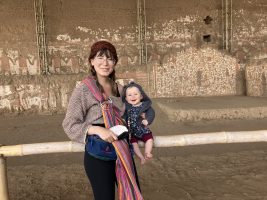 Breanna Reiss is a PhD candidate at the University of New Mexico who studies pre-Hispanic ceramics, primarily from coastal Ecuador and northern Peru, with a focus on their iconography and elements of their composition. She also received her MA from UNM where, in partnership with the Earth and Planetary Sciences Department, she examined the chemical composition of rare blue and blue-green post-fire ceramic figurine colorants from Ecuador. Her dissertation explores ancient Moche plant motifs, relating them to identifiable species and exploring their contextual relationships to narrative scenes. This plantcentric approach has identified several biomes and ecological indicators important to Moche culture. Along with teaching introductory art history courses, she has received numerous fellowships with UNM’s Center for Southwest Research and the Digital Initiatives and Scholarly Communication Department, and currently works for Georgia Tech Research Institute.
Breanna Reiss is a PhD candidate at the University of New Mexico who studies pre-Hispanic ceramics, primarily from coastal Ecuador and northern Peru, with a focus on their iconography and elements of their composition. She also received her MA from UNM where, in partnership with the Earth and Planetary Sciences Department, she examined the chemical composition of rare blue and blue-green post-fire ceramic figurine colorants from Ecuador. Her dissertation explores ancient Moche plant motifs, relating them to identifiable species and exploring their contextual relationships to narrative scenes. This plantcentric approach has identified several biomes and ecological indicators important to Moche culture. Along with teaching introductory art history courses, she has received numerous fellowships with UNM’s Center for Southwest Research and the Digital Initiatives and Scholarly Communication Department, and currently works for Georgia Tech Research Institute.
Jessica Monette is an interdisciplinary artist living in the Bay Area whose creative endeavors span the diverse realms of painting, sculpture, installation, and collage. Materiality forms the core of Monette’s artistic expression, each chosen element serving as a deliberate conduit for context and personal narrative. Her repertoire includes a wide array of materials—from house paint, plaster, and thin-set mortar to found and fabricated objects, site-specific soil, rope, nails, cotton, railroad spikes, water from the Mississippi River, and clothing collected from various family members. To New Orleans–born Monette, these materials aren’t just art components, her materials are agents for rebuilding and storytelling. The cataclysmic events of Hurricane Katrina in 2005 undergird her work and serve as a potent visual metaphor for contemporary colonial sediment, encapsulating a temporal lens that reveals the nuances of systemic oppressions. Economic inequality, gentrification, unequal aid distribution, environmental racism, forced migration, and the erosion of cultural heritage—Katrina becomes a concentrated manifestation of these issues.
Monette’s reconstruction of her familial archive, challenges systems of oppression that are created to perpetuate silence. The threads of her narrative, woven together through materials and thematic exploration, contribute to a powerful dialogue that invites viewers to reexamine the need for persistence of cultural memory and the tenacity of the human spirit.
Learn more about CAA Professional Development Fellowships here.
Millard Meiss Publication Fund: Apply Now + Congrats To Fall 2023 Grantees!
posted by CAA — January 22, 2024
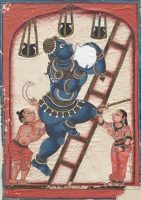
Krishna Stealing Curds, late 1700s, Andhra Pradesh, Tirupati. Gum tempera and gold on paper, 10 ⅞ x 7 ⅝ in. (27.7 x 19.3 cm). The Cleveland Museum of Art, John L. Severance Fund 1966.28
CAA is now accepting applications for the Millard Meiss Publication Fund. Twice yearly, grants are awarded through this fund to support book-length scholarly manuscripts in art history, visual studies, and related subjects which have been accepted by a publisher on their merits but cannot be published in the most desirable form without a subsidy. Thanks to the generous bequest of late Professor Millard Meiss, CAA has been awarding these grants since 1975.
Visit our website to learn more about the application process, criteria, and to apply.
Deadline: March 15, 2024
Congratulations to the Meiss Fall 2023 Grantees!
Joanna Fiduccia: Figures of Crisis: Alberto Giacometti and the Myths of Nationalism, Yale University Press
Mayu Fujikawa: Envisioning Diplomacy: Images of Japanese Ambassadors in Early Modern Europe, Penn State University Press
Kelly Presutti: Land into Landscape: Art, Environment, and the Making of Modern France, Yale University Press
Paula Richman: The Work of Art: India’s Mithila Painting, University of Washington Press
Anna Seastrand: Body, History, and Myth: Early Modern Murals in South India, Princeton University Press
Alicia Volk: In the Shadow of Empire: Art in Occupied Japan, University of Chicago Press
Meet the 2024 CAA Annual Conference Kress Travel Grant Recipients
posted by CAA — November 28, 2023
Recognizing the value of the exchange of ideas and experience among art historians, the Kress Foundation is offering support for scholars participating as speakers at the 2024 CAA Annual Conference. The scholarly focus of the papers must be European art before 1830.
Samuel H. Kress Foundation CAA Annual Conference Travel Fellows 2024

Michela Degortes, Researcher, University of Lisbon
“Approaching the Portrait Gallery of the Academy of Sciences of Lisbon”
Art Collections of Academies of Sciences
Chair: Viktor Oliver Lorincz
The Academy of Sciences of Lisbon was founded in 1779 under the patronage of Maria I of Braganza, thanks to the effort of enlightened figures of the Portuguese aristocracy, clergy, and scientific elite. A print published the same year in the Jornal Enciclopedico to celebrate the event represents the queen surrounded by a circle of learned courtesans while holding hands with a figure symbolizing Knowledge. A portrait of Maria I located in one of the main rooms of the Academy celebrates her role as a patron.
Painted by the Irish artist Thomas Hickey in 1783, it is part of the gallery of paintings held by the Academy of Sciences of Lisbon, which brings together the portraits of remarkable figures of the eighteenth- and nineteenth-century Portuguese cultural milieu. It includes portraits of other members of the royal family as well as of important members of the institute, such as José Francisco Correia da Serra, Manuel de Cenaculo, and Joseph Mayne, whose cabinet of curiosities constitutes the museum of the Academy. Despite the remarkable quality of many of these artworks and their influence on the Portuguese artistic context, the collection still lacks a deep investigation. This paper focuses on the sitters, the artists involved, and the donations that formed the collection, and gives rise to interesting comparisons to similar art collections held by other academies of science.
Charline Fournier-Petit, PhD candidate, University of Maryland and Lecturer, École du Louvre
“Elisa Bonaparte Baciocchi and Diplomacy: A Gift of Fourteen Portraits,”
Women and Diplomatic Art
Chair: Silvia Tita
Tense, if ever conflicting, were the relationships between Elisa Bonaparte Baciocchi, Grand Duchess of Tuscany, and her brother, the emperor Napoleon I. A clever ruler, she rapidly exploited the marble quarries of Carrara for diplomatic purposes, producing abundant portraits of the great sovereigns of her time. Sculpture also served her as a surrogate for diplomatic dialogue with the emperor to affirm her legitimacy as the sovereign of Tuscany and her daughter’s dynastic succession. In 1809, Elisa Bonaparte Baciocchi gifted a series of fourteen marble portraits depicting members of the Bonaparte family to Napoleon I, including her own bust and that of her daughter, Napoléone-Elisa. Extracted from her own quarries and intended for the busy Galerie de Diane at the Palais des Tuileries, this series in marble was both a political message sent not only to the childless emperor, but also to their siblings and to the court. With this gift, Elisa Bonaparte Baciocchi demonstrated her capability to impose her authority over a conquered province and restore the prestige of Carrara. And, by gathering quickly such a large number of sculptures, she was also displaying the production capacity of her marble quarries. The gift also epitomized her diplomatic strategy and dynastic aspiration, thorugh which Elisa Bonaparte Baciocchi turned her motherhood into a powerful argument supporting her political ambitions.
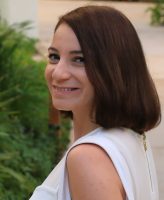
Gohar Grigoryan, , University of Fribourg, Switzerland
“An Illustrated Armenian Law Book and the Ceremonial Mise-en-scène of the King’s Body”
Medieval Ritual Representations: Model of or Model for?
Chairs: Alice Isabella Sullivan and Robert Nelson
A miniature created in 1331 in the Cilician Armenian capital of Sis depicts the young king Lewon IV (r. 1321–1341) at the tense moment of executing—according to the nearby inscription— “just judgment.” The full-page image serves as frontispiece to the oldest extant copy of the Assizes of Antioch—a now-lost Frankish legal code. An important monument of secular law, the Assizes of Antioch was influential beyond the Principality of Antioch and the crusader states, reaching the Armenian Kingdom of Cilicia (1198–1375). Its main purpose was the regulation of the relationship between the suzerain and his vassal lords, and it is exactly these relationships that are represented in the miniature in question, with the king seated on an elevated throne and executing justice over his lords. Initiated by the king himself, the juridical image of Lewon IV was heavily charged with realistic codes, idealizing symbols, and eschatological messages, the intended meanings of which will be tackled in my paper. I will first focus on how the king’s painter, Sargis Pitsak, visualized the ceremonial mise-en-scène around the sovereign’s imposing body and how the latter’s political agenda is reflected in this and other portrayals of him. The discussion continues with questions of visibility and the particular occasions at which the target audience could possibly see an emblematized image like this.

Laura Hutchingame, PhD candidate, University of California Los Angeles
“Red Larch at San Fermo: Ligneous Knowledge in the Upper Adriatic”
Wood: Medium Specificity in the Global Early Modern Period
Chair: Tatiana String
In the late medieval Adriatic, wood was a crucial natural resource and building material that required highly specialized knowledge. From felling alpine trees, preparing logs into rafts, floating rafts downriver, to storing and seasoning timbers, the preparation of lumber involved labor-intensive processes. The “ship-hull ceiling,” in the form of an inverted ship, was an important artifact that proliferated throughout the region from ca. 1300–1450 and was fostered by the collaboration between different wood-based artisans. The ceiling at the church of San Fermo in Verona, executed from ca. 1300–50, offers an exceptional case study. In addition to its innovative design, recent conservation work has uncovered material evidence of how artisans sourced appropriate lumber, prepared timbers, and crafted the ceiling from local red larch. I highlight the specialized ligneous knowledge of artisans who contributed to the production of the ceiling. I show how the ceiling (and wood itself) is a source of interconnections between patrons, artisans, political regimes, and religious orders of this time. At San Fermo, the material and physical qualities of wood are neither representational nor represented but are made visible through crafting.


Cynthia Kok, PhD candidate, Yale University, and Stephanie Archangel, Curator, Rijkmuseum
“Edvardt Abraham Akaboa de Moor, a Master Silversmith from Angola”
Center and Periphery?: Mapping a Future for Research in Netherlandish Art
Historians of Netherlandish Art
Chair: Stephanie Dickey
With origins as a “prestige project,” the Rijksmuseum grapples with the legacy of prioritizing upper-class artworks and narratives, leading to criticisms that the institution is a place of and for elites. Decorative arts within the collection, however, were rarely made by the upper classes. We turn to objects and archives to consider these marginalized makers more closely. We take as a case study a gun by Edvardt Abraham Akaboa de Moor. From archival research, we learn that de Moor was a Black man from Angola who likely found his way to the Netherlands via modern-day Ghana. By 1665, however, de Moor worked as a skilled weapons engraver as a member of the silversmith’s guild and lived with his Dutch wife and children in Utrecht. The Rijksmuseum’s flintlock hunting gun is signed “Edvardt Abraham de Moor” and “tot Utrecht,” claiming ownership of the lock, the most technically difficult part of the gun. As with other marginalized figures, little information remains of de Moor—certainly no portraits nor personal archives—yet traces of him and his descendants remain in the state archives and in museums. We ask, How do we recover the identity of individuals who operated and worked in craft workshops? Can a shift in focus to makers and archives allow museums to interrogate the narratives of marginalized peoples? And how can museums conscientiously address the question, to whom does the agency of craftsmanship belong?
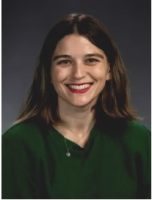 Caroline Delia Koncz, Assistant Professor, Angelo State University
Caroline Delia Koncz, Assistant Professor, Angelo State University
“Lavinia Fontana’s Minerva Unarmed: The Female Nude, as Seen and Painted by Woman”
What Did Women See? Gender and Viewing Experience in Early Modern Italy
Chair: Sabrina De Turk
Created shortly before the artist’s death in 1614, Lavinia Fontana painted a rather curious rendering of the virginal goddess of wisdom for Cardinal Scipione Borghese. Standing in profile, her head tilted speculatively towards the viewer, Minerva holds in her arms a sumptuous dress of luxurious fabrics and gold trim, which she is presumably about to don. Beside her in the room, one can find the deity’s pet owl alongside her previously adorned armor, helmet, and shield, all of which serve to identify the goddess. Such objects were likely necessary to include, since, beyond the subject of the Judgment of Paris, remarkably few Italian artists in the early modern period depicted Minerva unrobed, and even fewer were women. I consider the unique iconography of Fontana’s painting as well as the intended message this work held for its viewers in seventeenth-century Italy. In addition to considering the male owner’s reception of the piece, this talk will more closely study how female beholders of the period might have analyzed the nude Minerva, when fashioned by the hand of a woman painter.
Matthew Sova, PhD candidate, Johns Hopkins University
“Representations of Performance in the Konstanz Holy Sepulcher”
Medieval Ritual Representations: Model of or Model for?
Chairs: Alice Isabella Sullivan and Robert Nelson
Located in Konstanz Cathedral, a thirteenth-century holy sepulcher stands as significant material evidence for widespread medieval practices of architectural copying. Understood as a reconstruction of the Tomb of Christ aedicule in the Church of the Holy Sepulcher in Jerusalem, scholars emphasize the Konstanz holy sepulcher’s reliance on the plans, dimensions, spaces, and structures of its illustrious model. These interpretations often downplay variations in appearance and function between the two microarchitectural objects, as well as regional contexts for these deviations in the Konstanz copy. Specifically, the Konstanz holy sepulcher features an extensive sculptural program of figures from Christmas, Easter, and the early church, which has no precedent in the Jerusalem aedicule. My paper investigates these sculptures, linking them to a local tradition of religious performances undertaken in and around the Konstanz holy sepulcher. Numerous medieval texts from Konstanz describe ritualized Holy Week reenactments in the city’s cathedral, performed by the clergy outside of the Mass. These paraliturgical events emphasized the roles of the three Marys, apostles, and angels, central figures in the Konstanz object’s artistic program. I show that these sculptures not only visualized the scriptural events of Easter, but served as permanent, idealized representations of Holy Week performances. Consequently, I argue that the Konstanz holy sepulcher’s sculptural program both enhanced the function of the copy as a stage for paraliturgical drama, and perpetually reinscribed historical and spiritual connections between its associated medieval community and the site of Christ’s death and resurrection in Jerusalem.
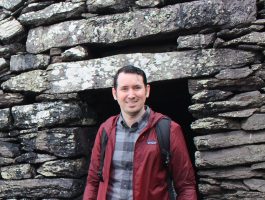 Mark H. Summers, Lecturer, University of Arkansas, Fayetteville
Mark H. Summers, Lecturer, University of Arkansas, Fayetteville
“Ritual Practice as Community Building in the Birds Head Haggadah”
Medieval Ritual Representations: Model of or Model for?
Chairs: Alice Isabella Sullivan and Robert Nelson
The Birds Head Haggadah, dated to around 1300 and produced in the Upper Rhine region of Southern Germany, is one of the earliest extant illuminated Ashkenazic haggadot, or manuscripts, that contain the ritualistic text recited at the Passover Seder. The book is well-known for its unusual approach toward figuration, styling Jewish people as hybrids with human bodies and heads of griffins, featuring the curving beaks of eagles and the pointed ears of lions. Throughout the manuscript, figurative illuminations in this style occupy the margins, enacting the historical events remembered at Passover and performing ritualistic activities associated with celebration of the feast. A pair of openings from the manuscript exemplifies this twofold approach. On folios 24v-25r, a scene from the Exodus unfolds across the lower margins. Though the story here refers to historical events of persecution, the figures that receive loaves of unrisen bread and turn to follow Moses appear in medieval styles of dress. While the story relates the flight from Egypt and pursuit by Egyptian soldiers, here the aggressors are likewise rendered as contemporary figures. As non-Jews, Pharoah and his soldiers appear as fully human figures with blank faces and are outfitted as German knights bearing the black eagle flag of the Holy Roman Empire. On the next opening spanning folios 25v-26r, the marginal program presents a scene of the ritualistic practice of making unleavened matzo, an act of abstinence that makes the historical suffering of the Jewish people tangible for the duration of Passover. The figures animating this scene, which is presented as a contemporary activity rather than a historical narrative, appear visually indistinct from the actors rendered in the previous opening. Here, the Jewish men and women working together to prepare dough, divide portions, and bake bread are all dressed in the same kinds of clothing as the followers of Moses, complete with modest hair coverings for women and the pointed hats worn by adult men that were at times compulsory accessories for men in northern medieval Europe. The approach in the visual program outlined in these openings creates a temporal elision connecting historical events with contemporary ritualistic practices. The result establishes the Passover Seder as what Marc Epstein calls a “metahistorical topos,” or a kind of temporal interconnectivity that links past, present, and future events and practices for the book’s users/viewers. I consider how the representation of ritual in the Birds Head Haggadah engages with metahistorical narratives to build community and identity for its medieval users.
 Joyce Zhou, PhD candidate and Teaching Fellow, Yale University
Joyce Zhou, PhD candidate and Teaching Fellow, Yale University
“Playing with Porcelain: Reimagining the Self with the Early Modern Dutch Dollhouse”
Miniature Designs and Worldly Simulations: Questions of Scale in Early Modern Arts
Chair: Wenjie Su
Sometime between 1743 and 1751, a Dutch woman named Sara Rothé assembled two elaborate dollhouses. Rothé describes a porcelain display room in one of her dollhouses, which survives today in the Kunstmuseum in The Hague. The room contains a variety of miniature arts, including miniature porcelain imported by the Dutch East India Company from China and Japan, as well as domestic imitations in ivory and glass. Pioneered by Amalia van Solms, Princess of Orange (1602–1675), this practice of dedicating entire rooms to the collection and display of East Asian porcelain was associated exclusively with female members of the House of Orange. While Rothé did not have the status nor financial means to recreate van Solms’ porcelain display in full-scale, she was able to successfully do so in the intimate realm of her dollhouse.
I explore the intersection of two early modern Dutch female collecting practices: the curation of dollhouses by wealthy Dutch women, and the formation of dedicated porcelain display chambers in Dutch royal circles. Building on the work of Hanneke Grootenboer and Susan Stewart, I argue that early modern Dutch dollhouses facilitated aspirational and imaginative thinking. Rothé’s porcelain room, which encapsulates Dutch royal porcelain chambers on a reduced scale, was a controlled and manipulable space in which Rothé adopted an alternate subjectivity and engaged in imaginative play. Here, Rothé could take on the persona of a Dutch royal, handling the various fruits of global commercial exchange as she engaged in immersive self-fashioning.
Wyeth Foundation Publication Grants for 2023
posted by CAA — November 17, 2023
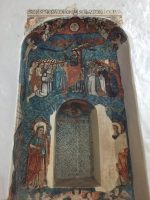
A photograph of a Maya Christian Mural of Yucatán. Credit: Amara Solari. All Rights Reserved.
Since 2005, the Wyeth Foundation for American Art has supported the publication of books on American art through the Wyeth Foundation for American Art Publication Grant, administered by CAA. The 2023 grantees are:
- Ellen Levy, A Book About Ray, MIT Press
- Ellen Macfarlane, Politics Unseen: Group F.64, Photography, and the Problem of Purity, University of California Press
- Yxta Maya Murray, We Make Each Other Beautiful: Art, Activism, and the Law, Cornell University Press
- Akela Reason, Politics and Memory: Civil War Monuments in Gilded Age New York, Yale University Press
- Amara Solari and Linda K. Williams, Maya Christian Murals in Early Modern Yucatán, University of Texas Press
Read a list of all recipients of the Wyeth Foundation for American Art Publication Grant from 2005 to the present.
BACKGROUND
For the Wyeth Foundation for American Art Publication Grant, “American art” is defined as art created in the United States, Canada, and Mexico. Eligible for the grant are book-length scholarly manuscripts in the history of American art, visual studies, and related subjects that have been accepted by a publisher on their merits but cannot be published in the most desirable form without a subsidy. The deadline for the receipt of applications is September 15 of each year.
Guidelines
Process, Materials, and Checklist
CONTACT
Questions? Please contact Cali Buckley, Manager of Grants and Awards, at cbuckley@collegeart.org.
Apply now for CAA’s Professional Development Fellowships for graduate students!
posted by CAA — September 15, 2023
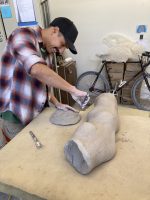
2022 Professional Development Honorable Mention in Visual Art Alberto Lozano Ruvalcaba in the studio
The Professional Development Fellowships program supports promising artists, designers, craftspersons, historians, curators, and critics who are enrolled in MFA, PhD, and other terminal degree programs. Fellows are honored with $10,000 unrestricted grants to help them with various aspects of their work.
One award will be presented to a practitioner—an artist, designer, and/or craftsperson—and one award will be presented to an art, architecture, and/or design historian, curator, or critic. Fellows also receive a free, one-year CAA membership and complimentary registration to the Annual Conference. Honorable mentions, given at the discretion of the jury, also earn a free one-year CAA membership and complimentary conference registration.
ARE YOU ELIGIBLE?
CAA seeks applications from students who are current members; will receive their MFA or PhD degree in the calendar year 2023, following the year of application (2024 for the current fellowship cycle); and have outstanding capabilities and demonstrate distinction in their contribution to art history and the visual arts.
HOW TO APPLY
See our website pages for the Professional Development Fellowship in Art History and the Professional Development Fellowship in Visual Arts for the full guidelines for each program and follow the APPLY NOW button.
DEADLINES
MFA and PhD Fellowships: November 15, 2023
CONTACT
For more information about the CAA Professional Development Fellowship program, Cali Buckley, Manager of Grants and Awards & Director of the CAA-Getty International Program, at cbuckley@collegeart.org.
Now Accepting Applications for the Wyeth Foundation and Millard Meiss Publication Grants for Fall 2023
posted by CAA — July 27, 2023
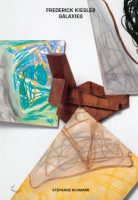
Fall 2022 Wyeth Foundation for American Art Publication Grant winner Stephanie Buhmann, Frederick Kiesler: Galaxies, The Green Box, Berlin, 2023
WYETH FOUNDATION FOR AMERICAN ART PUBLICATION GRANT
Since 2005, the Wyeth Foundation for American Art has supported the publication of books on American art through the Wyeth Foundation for American Art Publication Grant, administered by CAA.
For this grant program, “American art” is defined as art created in the United States, Canada, and Mexico. Eligible for the grant are book-length scholarly manuscripts in the history of American art, visual studies, and related subjects that have been accepted by a publisher on their merits but cannot be published in the most desirable form without a subsidy.
The deadline for the receipt of applications is September 15 of each year. Learn more about the Wyeth Foundation for American Art Publication Grant.
MILLARD MEISS PUBLICATION FUND
Twice a year, CAA awards grants through the Millard Meiss Publication Fund to support book-length scholarly manuscripts in the history of art, visual studies, and related subjects that have been accepted by a publisher on their merits, but cannot be published in the most desirable form without a subsidy. Thanks to the generous bequest of the late Prof. Millard Meiss, CAA began awarding these publishing grants in 1975.
Books eligible for a Meiss grant must currently be under contract with a publisher and be on a subject in the arts or art history.
The deadlines for the receipt of applications are March 15 and September 15 of each year. Learn more about the Millard Meiss Publication Fund.



